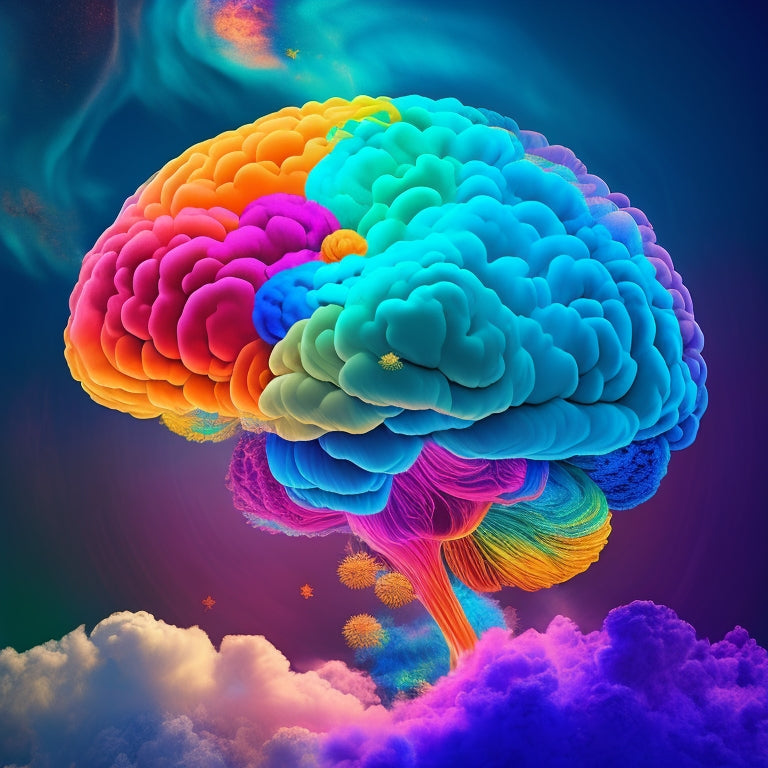
Mind Mapping Unveiled: Boosting Creativity and Structuring
Share
I've discovered the power of mind mapping in enhancing my creativity and structuring my thoughts. This visual tool helps me generate innovative ideas, eliminate unnecessary topics, and increase productivity. By breaking free from linear thinking, I can organize complex ideas, identify connections, and prioritize tasks efficiently. Mind mapping has transformed my writing process, too, allowing me to produce well-structured and coherent content. I've experienced the benefits firsthand, and I'm excited to share my knowledge with you. As I explore the depths of mind mapping, I'm discovering new ways to unleash my creative potential - and I'm excited to see where it takes me next.
Key Takeaways
• Mind mapping is a visual tool that boosts creativity, structures thoughts, and increases productivity, leading to quicker action and self-confidence.
• It helps eliminate unnecessary topics, encourages detailed posts, and provides a clear big picture, making it an effective problem-solving approach.
• By breaking free from linear lists, mind mapping allows thinking outside the box, challenging traditional methods, and fostering innovative ideas.
• This visual representation tool aids in organizing thoughts, prioritizing tasks, and identifying roadblocks, making it ideal for brainstorming and writing purposes.
• Mind mapping transforms ideas into written content seamlessly, generating innovative concepts, and producing well-structured, cohesive pieces that effectively convey messages.
Benefits and Challenges Uncovered
As I explored the world of mind mapping, I discovered that this visual tool can be a game-changer for boosting creativity and structuring thoughts, but it's not without its challenges.
I found that mind mapping can lead to quicker action and increased self-confidence, reducing confusion and clutter in my thoughts. It helps me eliminate unnecessary topics early on and encourages more detailed and longer posts. By visualizing concepts, I can increase productivity and see the big picture more clearly.
However, I also realized that mind mapping can be time-consuming, and it's easy to get caught up in organizing the map rather than taking action. Despite these challenges, I believe that mind mapping is a powerful tool that can help me achieve my goals and streamline my creative process.
Overcoming Skepticism and Doubts
Despite its potential benefits, I initially approached mind mapping with a healthy dose of skepticism, wondering if this visual tool was just a fancy way of making lists. I'd to overcome my own mind mapping misconceptions, debunked by the simplicity and effectiveness of the process.
I realized that mind mapping wasn't about creating a complicated diagram, but rather a structured way of organizing my thoughts. By challenging traditional methods, I discovered that mind mapping allowed me to think outside the box and break free from the constraints of linear lists.
It's not about replacing traditional methods, but about finding a new way to approach creativity and problem-solving.
My First Mind Mapping Experience
I initiated my first mind mapping experiment, utilizing the MindNode app to digitally map out a creative process in digital art, curious to see if this visual approach could bring order to the chaos of my thoughts.
As I started exploring creativity through mind mapping, I encountered initial struggles. Categorizing and organizing different elements proved confusing, and I struggled to fit all relevant information into one mind map.
Despite the initial hurdles, I found the MindNode app to be beginner-friendly and easy to use. I could easily move and delete elements, and the app allowed me to visualize my creative process and project structure efficiently.
Although my first experience wasn't as inspiring as I'd hoped, I realized that mind mapping could be a valuable tool in structuring my thoughts and ideas.
Mapping for Problem-Solving Purposes
By harnessing the power of mind mapping, I've discovered a unique approach to problem-solving that focuses on keywords as headers rather than processes, emphasizing flow and direction over repetition of keywords.
This method has revolutionized my creative brainstorming sessions, allowing me to visualize complex ideas and break them down into manageable chunks.
When it comes to project planning, mind mapping has been a game-changer, enabling me to organize my thoughts and prioritize tasks with ease.
I can now identify potential roadblocks and develop contingency plans, ensuring that my projects stay on track.
With mind mapping, I've found that I can tackle problems with confidence, and my creative output has increased significantly.
Structuring Thoughts for Effective Writing
In addition to applying mind mapping to the writing process, I've found that it enables me to structure my thoughts in a way that fosters clarity, coherence, and creativity.
By visually organizing my ideas, I can identify connections and relationships that might've gone unnoticed otherwise. This improved organization allows me to prioritize my thoughts, ensuring that my writing flows logically and stays focused on the main topic.
Additionally, mind mapping enhances my creativity by encouraging me to think outside the box and explore new ideas. By freeing my thoughts from the constraints of linear writing, I can generate innovative concepts and approaches that elevate my writing to the next level.
As a result, I'm able to produce well-structured, engaging content that effectively communicates my message to my audience.
Transforming Ideas Into Written Content
With a clear mind map in hand, the task of exploring ideas into written content becomes a seamless process. I've found that having a visual representation of my thoughts helps me organize and structure my writing, allowing for a smoother writing flow.
The mind map serves as a guide, directing me to investigate specific ideas and generate new ones. As I immerse into the writing process, I can easily refer back to the map, ensuring that I stay on track and cover all essential points.
This approach has greatly improved my idea generation, as I can see connections between concepts and identify areas that need further development. By transforming my mind map into written content, I'm able to produce well-structured and cohesive pieces that effectively convey my message.
Sharing Mind Maps and Experiences
I'm excited to share my mind maps and experiences with others, hoping to spark inspiration and foster a sense of community among fellow creatives. By sharing my visual storytelling, I aim to facilitate collaborative brainstorming and idea sharing. Here's how I plan to do it:
| Platform | Format | Benefits |
|---|---|---|
| Social Media | Image/Video | Reach a wider audience, spark discussions |
| Blogging | Written Post | Share detailed experiences, provide tutorials |
| Online Communities | Interactive Session | Engage in real-time collaborative brainstorming |
Through sharing my mind maps and experiences, I hope to inspire others to try this powerful tool and learn from each other's creative processes. By doing so, we can create a supportive community that fosters creative collaboration and idea sharing.
Frequently Asked Questions
Can I Use Mind Mapping for Both Personal and Professional Projects?
I can definitely use mind mapping for both personal and professional projects, as it helps me with goal setting and task management, allowing me to visualize and structure my ideas, and tackle tasks more efficiently.
How Do I Avoid Information Overload in My Mind Maps?
When creating mind maps, I prioritize filtering to avoid information overload by simplifying complexity, focusing on key concepts, and eliminating non-essential details, ensuring clarity and structure in my visual representation.
Are Mind Maps More Effective for Visual or Verbal Thinkers?
"I find mind maps more effective for visual thinkers like myself, as they tap into my cognitive style, but verbal thinkers can also benefit by using keywords and phrases to stimulate their learning preferences."
Can I Use Mind Mapping in Conjunction With Other Organizational Tools?
I find that combining mind mapping with other organizational tools, like digital calendars and task lists, enhances my productivity through digital integration and task prioritization, allowing me to stay focused and efficient in my writing projects.
Are There Any Specific Mind Mapping Techniques for Group Collaborations?
When leading group collaborations, I use mind mapping techniques like Collaborative Brainstorming and Group Facilitation to foster open communication, encouraging team members to share ideas and build upon each other's thoughts, resulting in cohesive and innovative solutions.
Related Posts
-

Under-Sink Storage Solutions for Urban Living
Under-sink areas in urban apartments can change from cluttered voids into efficient storage havens with smart solutio...
-

Waterproof Corner Storage Solutions for Bathrooms
Waterproof corner storage solutions are perfect for maximizing space in your bathroom. These stylish options employ u...
-

Revamp Your Home With Spring Cleaning Checklist
Spring's arrival presents a prime opportunity to transform your living space, shedding the remnants of winter's hiber...


